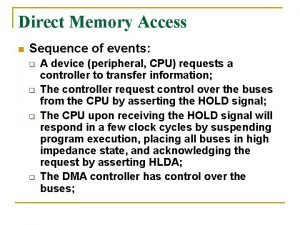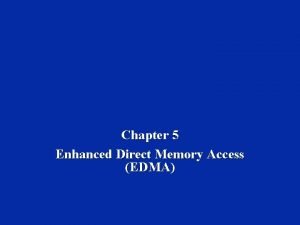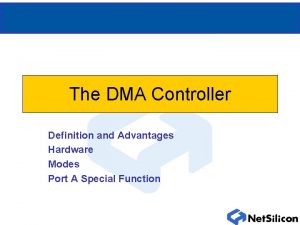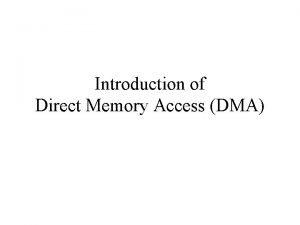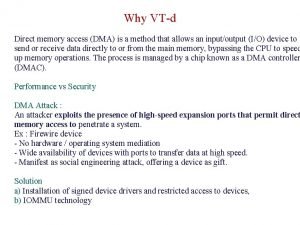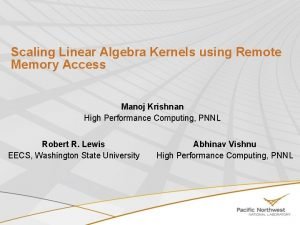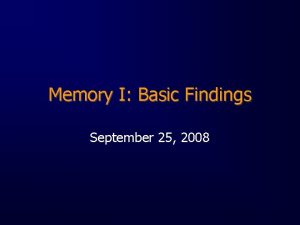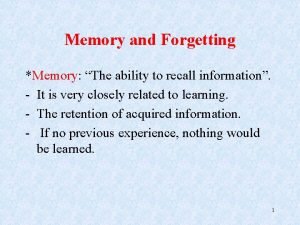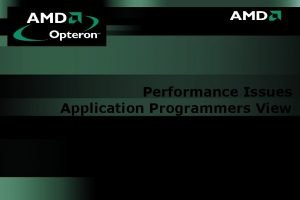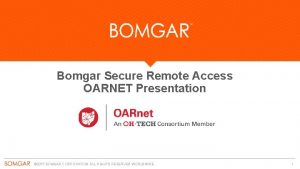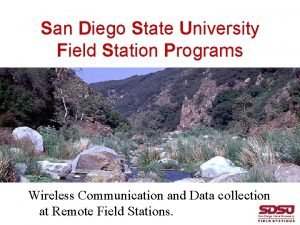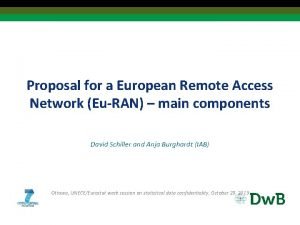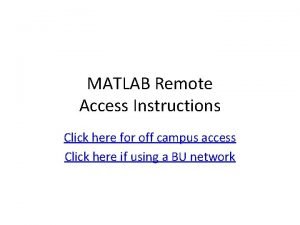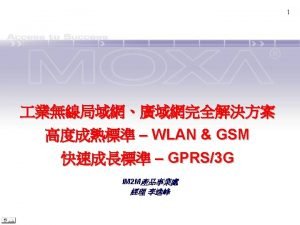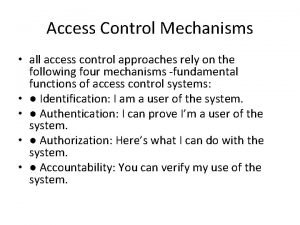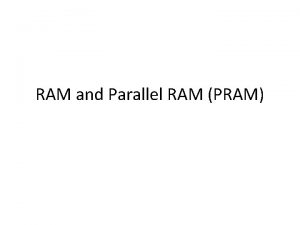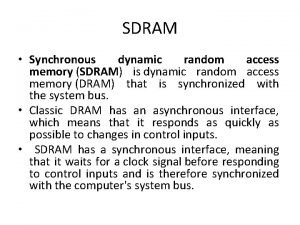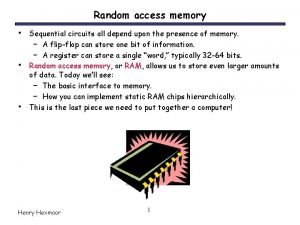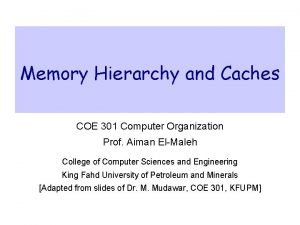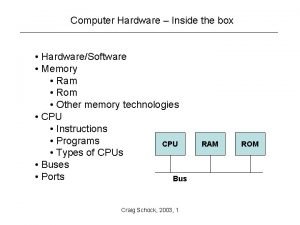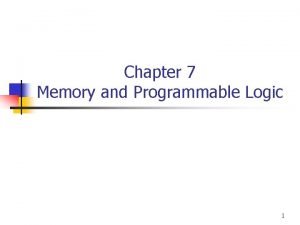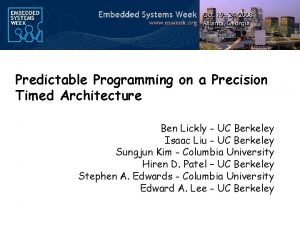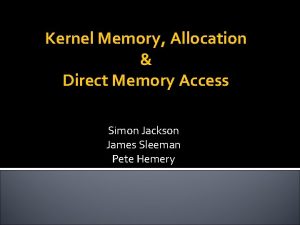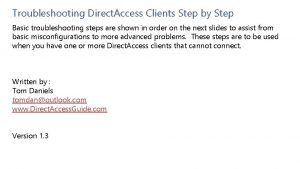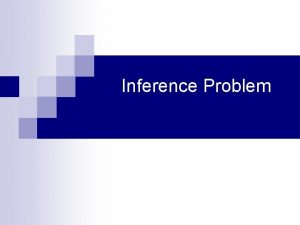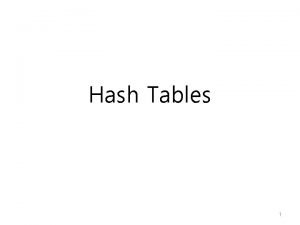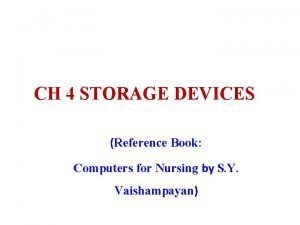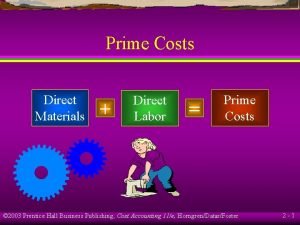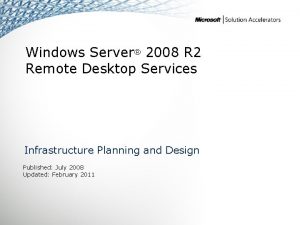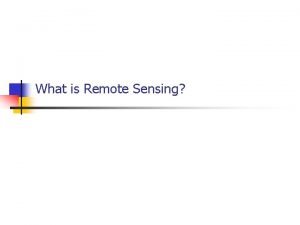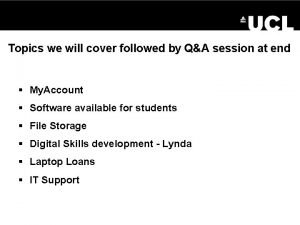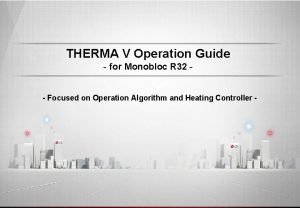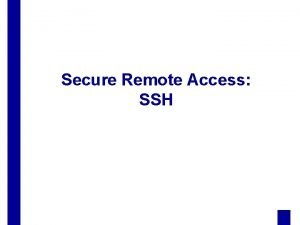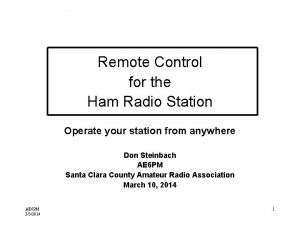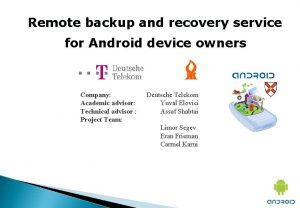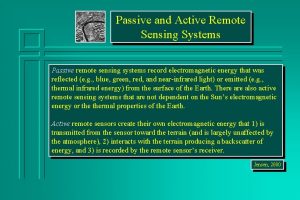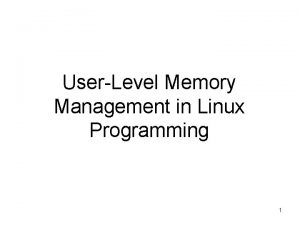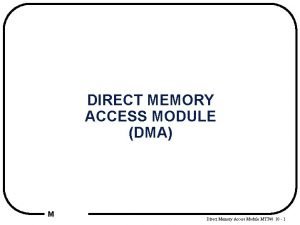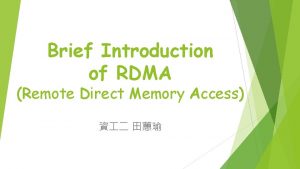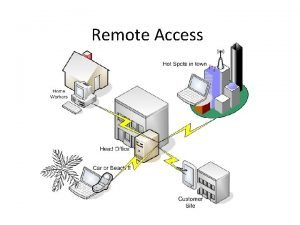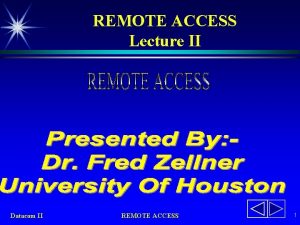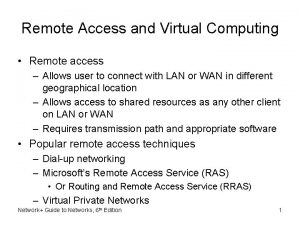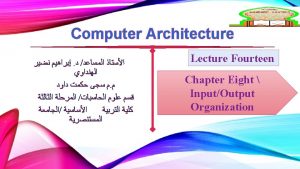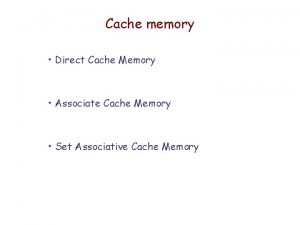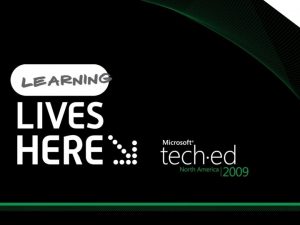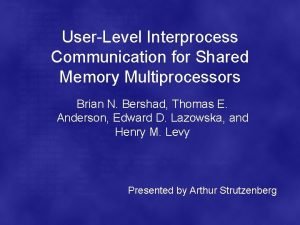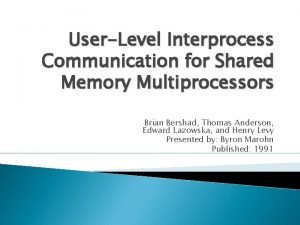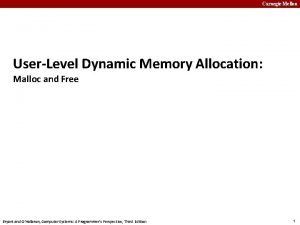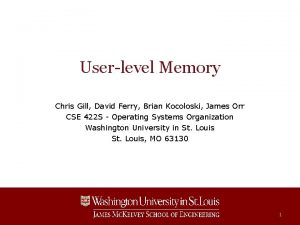HIGHPERFORMANCE NETWORKING REMOTE DIRECT MEMORY USERLEVEL NETWORKING ACCESS























![U-Net Communication: Send 12 START [NI] exerts backpressure to the user processes Is Queu U-Net Communication: Send 12 START [NI] exerts backpressure to the user processes Is Queu](https://slidetodoc.com/presentation_image/5f86e68106720692c2e76ca75cf19115/image-24.jpg)
![U-Net Communication: Receive 13 STA [NI] RT demultiplexes incoming messages to their destinations Read U-Net Communication: Receive 13 STA [NI] RT demultiplexes incoming messages to their destinations Read](https://slidetodoc.com/presentation_image/5f86e68106720692c2e76ca75cf19115/image-25.jpg)









































- Slides: 66

HIGH-PERFORMANCE NETWORKING : : REMOTE DIRECT MEMORY USER-LEVEL NETWORKING ACCESS CS 641 Moontae Lee (Nov 20, 2014) Part

Overview 00 Background User-level Networking (U-Net) Remote Direct Memory Access (RDMA) Performance

Index 00 Backgrou nd

Network Communication 01 Send Application �� buffer Socket buffer Attach �� headers Data �� is pushed to NIC buffer Receive NIC �� buffer Socket buffer Parsing �� headers Data �� is copied into Application buffer Application �� is scheduled (context switching)

Today’s Theme 02 Faster and lightweight communication!

Terms and Problems 03 Communication latency Processing �� overhead: message-handling time at sending/receiving ends Network �� latency: message transmission time between two ends (i. e. , end-to-end latency)

Terms and Problems 03 Communication latency Processing �� overhead: message-handling time at sending/receiving ends Network �� latency: message transmission time between two ends (i. e. , end-to-end latency) If network environment satisfies High �� bandwidth / Low network latency Long �� connection durations / Relatively few connections

TCP Offloading Engine (TOE) 04 THIS IS NOT OUR

Our Story 05 Large vs Small messages Large: �� transmission dominant new networks improves (e. g. , video/audio stream) Small: �� processing dominant new paradigm improves (e. g. , just a few hundred bytes)

Our Story 05 Large vs Small messages Large: �� transmission dominant new networks improves (e. g. , video/audio stream) Small: �� processing dominant new paradigm improves (e. g. , just a few hundred bytes) Our underlying picture Sending �� many small messages in LAN Processing �� overhead is overwhelming (e. g. , buffer management, message copies, interrupt)

Traditional Architecture 06 Problem: Messages pass through the kernel Low �� performance Duplicate several copies Multiple abstractions between device driver and user apps Low �� flexibility All protocol processing inside the kernel Hard to support new protocols and new message send/receive interfaces

History of High-Performance 07 User-level Networking (U-Net) One �� of the first kernel-bypassing systems Virtual Interface Architecture (VIA) First �� attempt to standardize user-level communication Combine �� U-Net interface with remote DMA service Remote Direct Memory Access (RDMA) Modern �� high-performance networking Many �� other names, but sharing common themes

Index 00 UNet

U-Net Ideas and Goals 08 Move protocol processing parts into user space! Move �� the entire protocol stack to user space Remove �� kernel completely from data communication path

U-Net Ideas and Goals 08 Move protocol processing parts into user space! Move �� the entire protocol stack to user space Remove �� kernel completely from data communication path Focusing on small messages, key goals are: High �� performance / High flexibility

U-Net Ideas and Goals 08 Move protocol processing parts into user space! Move �� the entire protocol stack to user space Remove �� kernel completely from data communication path Focusing on small messages, key goals are: High �� performance / High flexibility Low communication latency in local area setting Exploit full bandwidth Emphasis on protocol design and integration flexibility Portable to off-the-shelf communication hardware

U-Net Ideas and Goals 08 Move protocol processing parts into user space! Move �� the entire protocol stack to user space Remove �� kernel completely from data communication path Focusing on small messages, key goals are: High �� performance / High flexibility Low communication latency in local area setting Exploit full bandwidth Emphasis on protocol design and integration flexibility Portable to off-the-shelf communication hardware

U-Net Ideas and Goals 08 Move protocol processing parts into user space! Move �� the entire protocol stack to user space Remove �� kernel completely from data communication path Focusing on small messages, key goals are: High �� performance / High flexibility Low communication latency in local area setting Exploit full bandwidth Emphasis on protocol design and integration flexibility Portable to off-the-shelf communication hardware

U-Net Ideas and Goals 08 Move protocol processing parts into user space! Move �� the entire protocol stack to user space Remove �� kernel completely from data communication path Focusing on small messages, key goals are: High �� performance / High flexibility Low communication latency in local area setting Exploit full bandwidth Emphasis on protocol design and integration flexibility Portable to off-the-shelf communication hardware

U-Net Ideas and Goals 08 Move protocol processing parts into user space! Move �� the entire protocol stack to user space Remove �� kernel completely from data communication path Focusing on small messages, key goals are: High �� performance / High flexibility Low communication latency in local area setting Exploit full bandwidth Emphasis on protocol design and integration flexibility Portable to off-the-shelf communication hardware

U-Net Architecture 09 Traditionally Kernel �� controls network All ��communications via the kernel U-Net Applications �� can access network directly via MUX Kernel �� involves only in connection setup * Virtualize NI provides each process the illusion of owning interface to network

U-Net Building Blocks 10 End points: application’s / kernel’s handle into network Communication segments: memory buffers for sending/receiving messages data Message queues: hold descriptors for messages that are to be sent or have been received

U-Net Communication: Initialize 11 Initialization: Create �� single/multiple endpoints for each application Associate �� a communication segment and send/receive/free message queues with each endpoint
![UNet Communication Send 12 START NI exerts backpressure to the user processes Is Queu U-Net Communication: Send 12 START [NI] exerts backpressure to the user processes Is Queu](https://slidetodoc.com/presentation_image/5f86e68106720692c2e76ca75cf19115/image-24.jpg)
U-Net Communication: Send 12 START [NI] exerts backpressure to the user processes Is Queu e Full? [NI] leaves the descriptor in the queue NEGATI VE Composes the data in the communication segment Associated send buffer can be reused Push a descriptor for the message onto the send queue [NI] indicates messages injection status by flag Backe dup? [NI] picks up the message and inserts into the network POSITI VE Send as simple as changing one or two
![UNet Communication Receive 13 STA NI RT demultiplexes incoming messages to their destinations Read U-Net Communication: Receive 13 STA [NI] RT demultiplexes incoming messages to their destinations Read](https://slidetodoc.com/presentation_image/5f86e68106720692c2e76ca75cf19115/image-25.jpg)
U-Net Communication: Receive 13 STA [NI] RT demultiplexes incoming messages to their destinations Read the data using the descriptor from the receive queue Periodically check the status of queue pollin g Get available space from the free queue Receiv e Model ? Transfer data into the appropriate comm. segment Push message descriptor to the receive queue event driven Use upcall to signal the arrival Receive as simple as NIC changing one or two

U-Net Protection 14 Owning process protection Endpoints �� Communication �� segments Send/Receive/Free �� queues Tag protection Only owning process can access! Outgoing �� messages are tagged with the originating endpoint address Incoming �� messages are only delivered to the correct destination endpoint

U-Net Zero Copy 15 Base-level U-Net (might not be ‘zero’ copy) Send/receive �� needs a buffer Requires �� a copy between application data structures and the buffer in the communication segment Can �� also keep the application data structures in the buffer without requiring a copy Direct Access U-Net (true ‘zero’ copy) Span �� the entire process address space But �� requires special hardware support to check address

Index 00 RDM A

RDMA Ideas and Goals 16 Move buffers between two applications via network Once programs implement RDMA: Tries �� to achieve lowest latency and highest throughput Smallest �� CPU footprint

RDMA Architecture (1/2) 17 Traditionally, �� socket interface involves the kernel Has �� a dedicated verbs interface instead of the socket interface Involves �� the kernel only on control path Can �� access r. NIC directly from user space on data path bypassing kernel

RDMA Architecture (2/2) 18 To ��initiate RDMA, establish data path from RNIC to application memory Verbs �� interface provide API to establish these data path Once �� data path is established, directly read from/write to buffers Verbs �� interface is different from the traditional socket interface.

RDMA Building Blocks 19 Applications use verb interfaces in order to Register �� memory: kernel ensures memory is pinned and accessible by DMA Create �� a queue pair (QP): a pair of send/receive queues Create �� a completion queue (CQ): RNIC puts a new completionqueue element into the CQ after an operation has completed. Send/receive �� data

RDMA Communication (1/4) 20 1 Step

RDMA Communication (2/4) 21 2 Step

RDMA Communication (3/4) 22 3 Step

RDMA Communication (4/4) 23 4 Step

Index 00 Performan ce

U-Net Performance: Bandwidth 24 * UDP bandwidth size of messages * TCP bandwidth data generation by application

U-Net Performance: Latency 25 End-to-end round trip latency size of messages

RDMA Performance: CPU load 26 CPULoad

Modern RDMA • Several major vendors: Qlogic (Infiniband), Mellanox, Intel, Chelsio, others • RDMA has evolved from the U/Net approach to have three “modes” • Infiniband (Qlogic PSM API): one-sided, no “connection setup” • More standard: “qpair” on each side, plus a binding mechanism (one queue is for the sends, or receives, and the other is for sensing completions) • One-sided RDMA: after some setup, allows one side to read or write to the memory managed by the other side, but prepermission is required • RDMA + VLAN: needed in data centers with multitenancy

Modern RDMA • Memory management is tricky: • Pages must be pinned and mapped into IOMMU • Kernel will zero pages on first allocation request: slow • If a page is a mapped region from a file, kernel may try to automatically issue a disk write after updates, costly • Integration with modern NVRAM storage is “awkward” • On multicore NUMA machines, hard to know which core owns a particular memory page, yet this matters • Main reason we should care? • RDMA runs at 20, 40 Gb/s. And soon 100, 200… 1 Tb/s • But memcpy and memset run at perhaps 30 Gb/s

Soft. ROCE • Useful new option • With standard RDMA may people worry programs won’t be portable and will run only with one kind of hardware • Soft. ROCE allows use of the RDMA software stack (libibverbs. dll) but tunnels via TCP hence doesn’t use hardware RDMA at all • Zero-copy sends, but needs one-copy for receives • Intel i. Warp is aimed at something similar • Tries to offer RDMA with zero-copy on both sides under the TCP API by dropping TCP into the NIC • Requires a special NIC with an RDMA chip-set

HIGH-PERFORMANCE NETWORKING USER-LEVEL NETWORKING : : REMOTE DIRECT MEMORY ACCESS CS 641 Jaeyong Sung (Nov 20, Part

Hadoop 2 Big Data � very common in industries e. g. Facebook, Google, Amazon, … Hadoop � open source Map. Reduce for handling large data � require lots of data transfers

Hadoop Distributed File System 3 primary storage for Hadoop clusters � both Hadoop Map. Reduce and HBase rely on it communication intensive middleware � layered on top of TCP/IP

Hadoop Distributed File System 4 highly reliable fault-tolerant replications in data-intensive applications, network performance becomes key component HDFS write: replication

Software Bottleneck 5 Using TCP/IP on Linux, � TCP echo

RDMA for HDFS 6 data structure for Hadoop � <key, value> pairs � stored in data blocks of HDFS Both write(replication) and read can take advantage of RDMA

Fa. RM: Fast Remote Memory 7 relies on cache coherent DMA � object’s stored version number both in the first word of the object header and at the start of each cache line NOT visible to the application (e. g. HDFS)

Traditional Lock-free reads 8 For updating the data,

Traditional Lock-free reads 9 Reading requires three accesses

Fa. RM Lock-free Reads 10 Fa. RM relies on cache coherent DMA Version info in each of cachelines

Fa. RM Lock-free Reads 11 single RDMA read

Fa. RM: Distributed Transactions 12 general mechanism to ensure consistency Two-stage commits (checks version number)

Shared Address Space 13 shared address space consists of many shared memory regions consistent hashing for mapping region identifier to the machine that stores the object � each machine is mapped into k virtual rings

14 Transactions in Shared Address Space Strong consistency Atomic execution of multiple operations Shared Address Space Rea d Write Rea d Allo Write Fre c e

Communication Primitives 15 One-sided RDMA reads � to access data directly RDMA writes � circular buffer is used for unidirectional channel � one buffer for each sender/receiver pair � buffer is stored on receiver

16 benchmark on communication primitives

Limited cache space in NIC 17 Some Hadoop clusters can have hundreds and thousands of nodes Performance of RDMA can suffer as amount of memory registered increases � NIC will run out of space to cache all page tables

Limited cache space in NIC 18 Fa. RM’s solution: Phy. Co � kernel driver that allocates a large number of physically contiguous and naturally aligned 2 GB memory regions at boot time � maps the region into the virtual address space aligned on a 2 GB boundary

Phy. Co 19

Limited cache space in NIC 20 Phy. Co still suffered as number of clusters increased � because it can run out of space to cache all queue pair 2 2 queue pairs per machine × �� �� = number of machines, �� = number of threads per machine � single connection between a thread and each remote machine 2 × �� � queue pair sharing among �� threads 2 × �� / ��

Connection Multiplexing 21 best value of q depends on cluster size

Experiments 22 Key-value store: lookup scalability

Experiments 23 Key-value store: varying update rates
 Direct memory access diagram
Direct memory access diagram Edma memory
Edma memory Dma advantages and disadvantages
Dma advantages and disadvantages Basic dma operation
Basic dma operation Direct memory access in os
Direct memory access in os Software defined networking vs traditional networking
Software defined networking vs traditional networking Remote memory
Remote memory Remote memory
Remote memory Remote memory
Remote memory Remote memory
Remote memory How to access tally remotely
How to access tally remotely Decs remote access
Decs remote access Telenursing and remote access telehealth
Telenursing and remote access telehealth Bomgar secure remote access
Bomgar secure remote access Distributed file system definition
Distributed file system definition Sdsu remote access
Sdsu remote access European commission remote access
European commission remote access Matlab remote access
Matlab remote access Csd remote access
Csd remote access Since the bastion host stands as a sole defender
Since the bastion host stands as a sole defender Episodic vs semantic memory
Episodic vs semantic memory Explicit and implicit memory
Explicit and implicit memory Long term memory vs short term memory
Long term memory vs short term memory Internal memory and external memory
Internal memory and external memory Primary memory and secondary memory
Primary memory and secondary memory Logical address
Logical address Which memory is the actual working memory?
Which memory is the actual working memory? Virtual memory
Virtual memory Virtual memory in memory hierarchy consists of
Virtual memory in memory hierarchy consists of Eidetic memory vs iconic memory
Eidetic memory vs iconic memory Symmetric shared memory architecture
Symmetric shared memory architecture Pram models
Pram models Double data rate synchronous dynamic random access memory
Double data rate synchronous dynamic random access memory Access memory
Access memory Access memory
Access memory Computer hardware
Computer hardware Access memory
Access memory What are the advantages of arrays?
What are the advantages of arrays? Memory access time
Memory access time Memory access pattern
Memory access pattern Terminal access controller access control system plus
Terminal access controller access control system plus Terminal access controller access-control system
Terminal access controller access-control system Advantages and disadvantages of cache memory
Advantages and disadvantages of cache memory Direct memory management
Direct memory management Direct access troubleshooting
Direct access troubleshooting Direct access control
Direct access control Hash
Hash Direct access trading
Direct access trading Direct data access
Direct data access 4 storage devices of computer
4 storage devices of computer Direct material + direct labour
Direct material + direct labour Remote desktop virtualization host role server 2012
Remote desktop virtualization host role server 2012 N-rays
N-rays Dts rx1 receiver manual
Dts rx1 receiver manual Dts gate motor limits
Dts gate motor limits Victron global remote
Victron global remote Ucl software database
Ucl software database Lg therma v error code ch14
Lg therma v error code ch14 3 norms of morality
3 norms of morality Esrs emc
Esrs emc Ssh_msg_kexinit
Ssh_msg_kexinit Secure remote login ssh
Secure remote login ssh Remote sensing platforms
Remote sensing platforms Remote control system da vinci
Remote control system da vinci Remote ham radio control
Remote ham radio control Remote backup android
Remote backup android Passive remote sensing
Passive remote sensing
